How to Write a Perfect Persuasive Essay
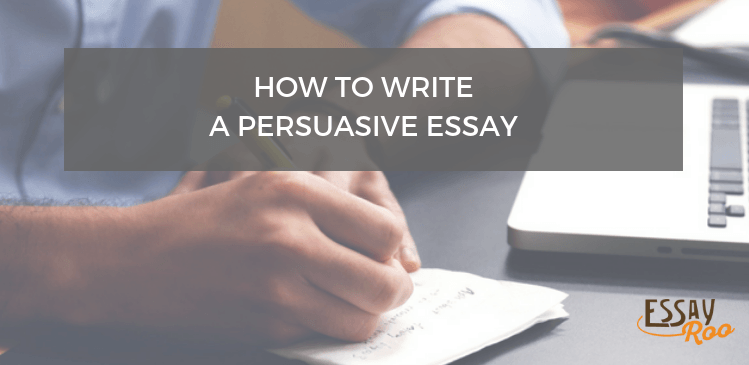

Table of contents:
- Structure and format
Persuasive vs. argumentative essay
- Persuasive essay introduction
- Persuasive essay body part
- Persuasive essay conclusion
Writing tips
A persuasive essay is an important tool in an Australian student’s repertoire. It will be useful not only for your assignments, but sets a good foundation for your life outside of high school, VET, or university as well, when you may have to negotiate with bosses, persuade customers to purchase your amazing goods, or even calm down an upset child.
But how do you write a 5 paragraph persuasive essay which will get you that coveted high grade? Your teacher or professor will be using a specific rubric to set your grades for these kinds of assignments. Let’s take a look.
Persuasive essay structure and format
The basic structural persuasive essay outline is, indeed, 5 paragraphs. It can be more, of course, and often will be, as you should try to keep each point supporting your main argument, or thesis , to one paragraph.
Typical structure for a persuasive essay:
- Introduction
- Body paragraphs (3 or more)
This is the fundamental layout: you will start with one paragraph as an introduction, then go on to write three or more paragraphs containing the body of your essay, then finally your conclusion, wrapping everything up with a neat little bow on top.
You may have also heard of argumentative essays and wonder what the difference is from a persuasive essay. Simply put, an argumentative essay must be based on cold hard facts which have been researched and are verifiable. It must be an essay devoted to the arguments in favour of a particular topic.
However, a persuasive essay has a wider range of resources available, as its only goal is to persuade the reader of the thesis. You can use appeals to emotion, social validation, stories and anecdotes, as well as of course facts and logic to persuade your audience. Think of the difference between a politician trying to persuade people to vote for him or her versus a scientist laying out the evidence they have gathered.
Part 1: Persuasive essay introduction
You begin with a hook , grabbing your audience’s attention from the start with your very first sentence. This can take the form of a relevant quote, or perhaps a personal anecdote, an interesting statistic or fact, an outrageous statement, or a question.
Having seized your reader’s attention, you will need to define who that reader should be. Make the definition of your intended audience clear, whether that’s your teacher, your fellow students, cat owners, fans of Star Wars, or Pokémon collectors.
The third and final part of the intro should consist of your thesis . This is a clear, strong, focused sentence that tells the reader the specific topic or purpose you’re writing about. It is your essay’s foundation, and everything else you will say in the essay rests on it. This is not the time to be wishy-washy or half-hearted; you must take an active, bold stance on the issue of your choice.
If you are not sure how to start persuasive essay, or feel you need prompts or samples of ideas, try looking at the news, whether local to your college or high school, or Aussie news in general. Use the techniques of making a checklist of questions or opinions you have about the world or about Australia, then proceed step by step through your worksheet. Do some research about your topics and find out which one inspires you the most.
Once you’ve made your thesis statement you can continue onward and write the body of your essay.
Part 2: Persuasive essay body paragraphs
Your essay’s body is the meat of the essay. It’s where you do the actual persuading to convince people to believe in your thesis. You should have at least three paragraphs’ worth of evidence for your argument, and if you do not, it’s likely that your thesis isn’t strong enough. If that’s the case, take a step back, and come up with ideas for a statement you feel strongly about, and take your topic from there.
Each separate point you make in defence of your thesis should be contained in a body paragraph of its own, and any facts, examples, stats, or quotes backing up that point included in the same paragraph. Take the time to fully examine each of your points and their meaning. You will also need to consider what someone who disagreed with your thesis might say in response and try to counteract their argument before they can make it.
If appropriate, it may well be worth conceding to, or finding common ground with, any opponents. Anticipating their arguments and agreeing where necessary is a show of strength and confidence on your part. On the other hand, a failure to address an obvious opposing argument looks weak and unprepared, so make sure you’ve got all your ducks in a row.
Part 3: Persuasive essay conclusion
Once you reach the conclusion of your essay, your audience should be at the point of agreeing with you. The conclusion is just to reinforce what they have already been told and leave them with a call to action so that they will carry on with their day in a somewhat different frame of mind than they were when they started reading your essay.
Begin your conclusion by restating your thesis, then your main points. This is important to keep the information fresh in their minds. Once you’ve done this, then close with the idea of the action you want them to take, whether that’s a question for them to think about, a prediction of what might happen in the future, or a literal call for them to do something, like donate to a particular charity or sign a petition.
Now you know how to write a persuasive essay, and are hopefully on your way to great grades. If you still need help, see the writing tips below.
- As you move between points on towards the inevitable conclusion, use transition words and phrases as sentence starters, as they serve as cues for the audience that the argument is moving onward. Some examples of these words are: however , therefore , consequently , in fact , on the other hand , instead , thus , and still .
- If you are truly stuck, why not consider if you can buy persuasive essay online? Another writer’s pages or papers can provide you with a template for the structure or serve as a generator for your own thoughts.
- Persuasive essay writing is like planning a house somewhere in Australia. Think of your thesis as the roof of a building, and each of your supporting points as pillars underneath it. Like a real roof, it has to have at least three pillars to stay up, and the more, the sturdier the whole argument is.
- The titles of your persuasive essays should be a pared-down version of your thesis statements.
- Essay samples
- Infographics
- Essay writing
- Crafting a Powerful Essay on Political Polarization
- Oral Health Overview Essay: Preventing Tooth Decay in Australia
- How to Write a Good Expository Essay About Macbeth
- How to Write An Expository Essay About Love
- How to Write a Great Expository Essay About Life
Price per page
Total price:
Limitless Amendments
Bibliography
Plagiarism Report
Get all these features for A$93.12 FREE
If you don't know exactly what type of paper you need or can't find the necessary one on the website - don't worry! Contact us and we'll help you out!
Before continuing to use our service please make sure you got acquainted with our Cookie Policy and accepted it by clicking OK
How to Write a Persuasive Essay: Tips and Tricks

By Allison Bressmer
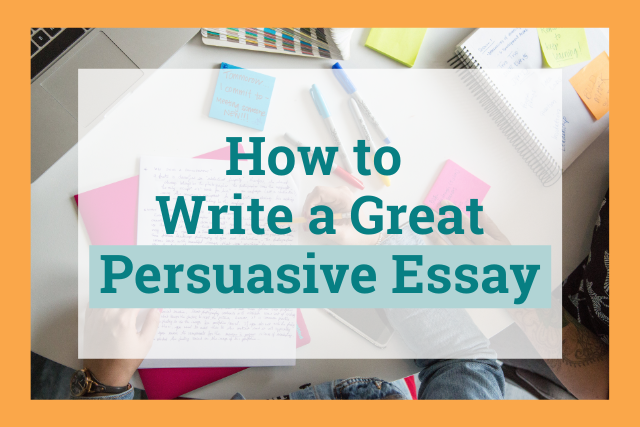
Most composition classes you’ll take will teach the art of persuasive writing. That’s a good thing.
Knowing where you stand on issues and knowing how to argue for or against something is a skill that will serve you well both inside and outside of the classroom.
Persuasion is the art of using logic to prompt audiences to change their mind or take action , and is generally seen as accomplishing that goal by appealing to emotions and feelings.
A persuasive essay is one that attempts to get a reader to agree with your perspective.
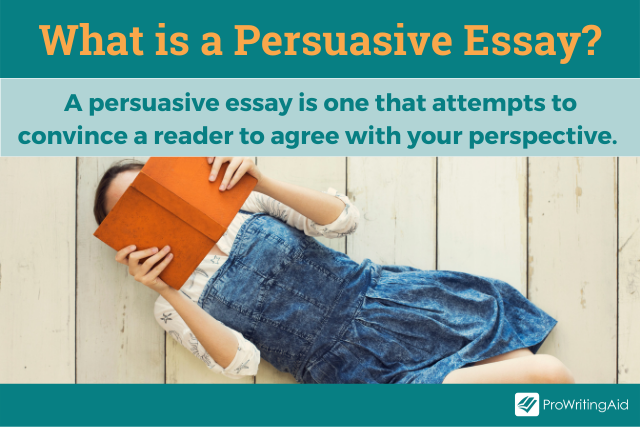
Ready for some tips on how to produce a well-written, well-rounded, well-structured persuasive essay? Just say yes. I don’t want to have to write another essay to convince you!
How Do I Write a Persuasive Essay?
What are some good topics for a persuasive essay, how do i identify an audience for my persuasive essay, how do you create an effective persuasive essay, how should i edit my persuasive essay.
Your persuasive essay needs to have the three components required of any essay: the introduction , body , and conclusion .
That is essay structure. However, there is flexibility in that structure.
There is no rule (unless the assignment has specific rules) for how many paragraphs any of those sections need.
Although the components should be proportional; the body paragraphs will comprise most of your persuasive essay.
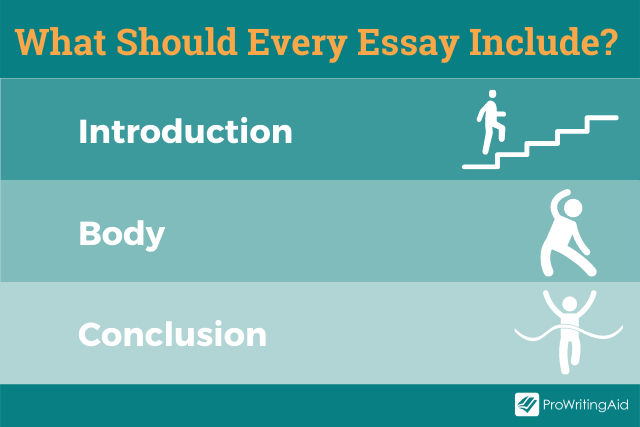
How Do I Start a Persuasive Essay?
As with any essay introduction, this paragraph is where you grab your audience’s attention, provide context for the topic of discussion, and present your thesis statement.
TIP 1: Some writers find it easier to write their introductions last. As long as you have your working thesis, this is a perfectly acceptable approach. From that thesis, you can plan your body paragraphs and then go back and write your introduction.
TIP 2: Avoid “announcing” your thesis. Don’t include statements like this:
- “In my essay I will show why extinct animals should (not) be regenerated.”
- “The purpose of my essay is to argue that extinct animals should (not) be regenerated.”
Announcements take away from the originality, authority, and sophistication of your writing.
Instead, write a convincing thesis statement that answers the question "so what?" Why is the topic important, what do you think about it, and why do you think that? Be specific.
How Many Paragraphs Should a Persuasive Essay Have?
This body of your persuasive essay is the section in which you develop the arguments that support your thesis. Consider these questions as you plan this section of your essay:
- What arguments support your thesis?
- What is the best order for your arguments?
- What evidence do you have?
- Will you address the opposing argument to your own?
- How can you conclude convincingly?

TIP: Brainstorm and do your research before you decide which arguments you’ll focus on in your discussion. Make a list of possibilities and go with the ones that are strongest, that you can discuss with the most confidence, and that help you balance your rhetorical triangle .
What Should I Put in the Conclusion of a Persuasive Essay?
The conclusion is your “mic-drop” moment. Think about how you can leave your audience with a strong final comment.
And while a conclusion often re-emphasizes the main points of a discussion, it shouldn’t simply repeat them.
TIP 1: Be careful not to introduce a new argument in the conclusion—there’s no time to develop it now that you’ve reached the end of your discussion!
TIP 2 : As with your thesis, avoid announcing your conclusion. Don’t start your conclusion with “in conclusion” or “to conclude” or “to end my essay” type statements. Your audience should be able to see that you are bringing the discussion to a close without those overused, less sophisticated signals.

If your instructor has assigned you a topic, then you’ve already got your issue; you’ll just have to determine where you stand on the issue. Where you stand on your topic is your position on that topic.
Your position will ultimately become the thesis of your persuasive essay: the statement the rest of the essay argues for and supports, intending to convince your audience to consider your point of view.
If you have to choose your own topic, use these guidelines to help you make your selection:
- Choose an issue you truly care about
- Choose an issue that is actually debatable
Simple “tastes” (likes and dislikes) can’t really be argued. No matter how many ways someone tries to convince me that milk chocolate rules, I just won’t agree.
It’s dark chocolate or nothing as far as my tastes are concerned.
Similarly, you can’t convince a person to “like” one film more than another in an essay.
You could argue that one movie has superior qualities than another: cinematography, acting, directing, etc. but you can’t convince a person that the film really appeals to them.

Once you’ve selected your issue, determine your position just as you would for an assigned topic. That position will ultimately become your thesis.
Until you’ve finalized your work, consider your thesis a “working thesis.”
This means that your statement represents your position, but you might change its phrasing or structure for that final version.
When you’re writing an essay for a class, it can seem strange to identify an audience—isn’t the audience the instructor?
Your instructor will read and evaluate your essay, and may be part of your greater audience, but you shouldn’t just write for your teacher.
Think about who your intended audience is.
For an argument essay, think of your audience as the people who disagree with you—the people who need convincing.
That population could be quite broad, for example, if you’re arguing a political issue, or narrow, if you’re trying to convince your parents to extend your curfew.
Once you’ve got a sense of your audience, it’s time to consult with Aristotle. Aristotle’s teaching on persuasion has shaped communication since about 330 BC. Apparently, it works.
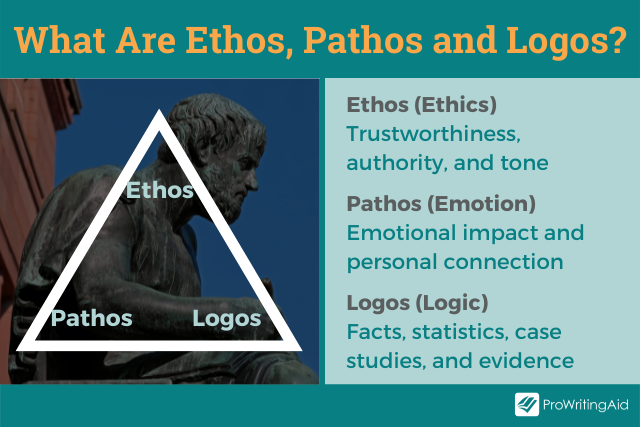
Aristotle taught that in order to convince an audience of something, the communicator needs to balance the three elements of the rhetorical triangle to achieve the best results.
Those three elements are ethos , logos , and pathos .
Ethos relates to credibility and trustworthiness. How can you, as the writer, demonstrate your credibility as a source of information to your audience?
How will you show them you are worthy of their trust?
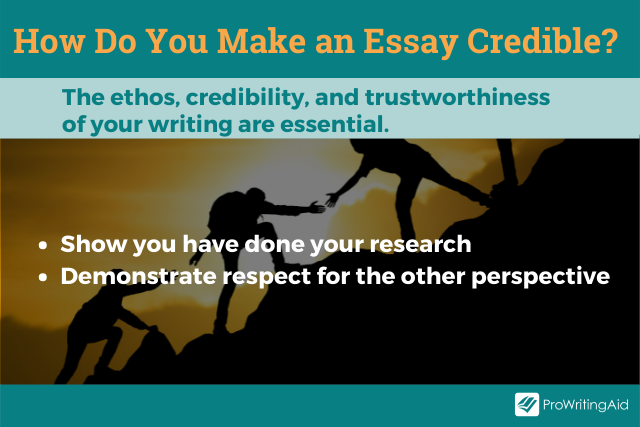
- You show you’ve done your research: you understand the issue, both sides
- You show respect for the opposing side: if you disrespect your audience, they won’t respect you or your ideas
Logos relates to logic. How will you convince your audience that your arguments and ideas are reasonable?
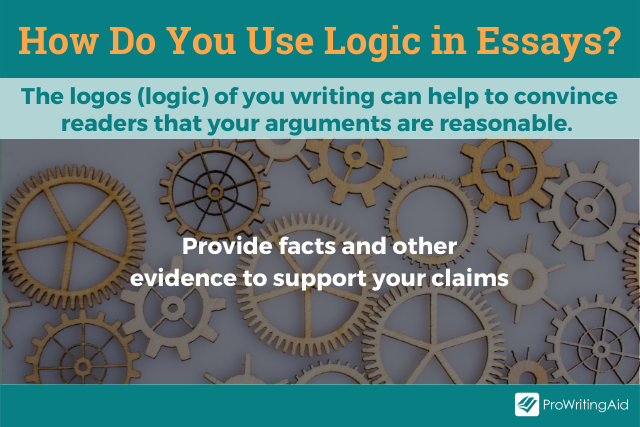
You provide facts or other supporting evidence to support your claims.
That evidence may take the form of studies or expert input or reasonable examples or a combination of all of those things, depending on the specific requirements of your assignment.
Remember: if you use someone else’s ideas or words in your essay, you need to give them credit.
ProWritingAid's Plagiarism Checker checks your work against over a billion web-pages, published works, and academic papers so you can be sure of its originality.
Find out more about ProWritingAid’s Plagiarism checks.
Pathos relates to emotion. Audiences are people and people are emotional beings. We respond to emotional prompts. How will you engage your audience with your arguments on an emotional level?
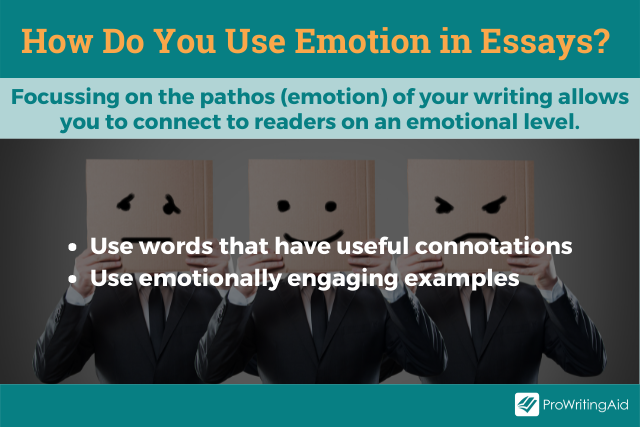
- You make strategic word choices : words have denotations (dictionary meanings) and also connotations, or emotional values. Use words whose connotations will help prompt the feelings you want your audience to experience.
- You use emotionally engaging examples to support your claims or make a point, prompting your audience to be moved by your discussion.
Be mindful as you lean into elements of the triangle. Too much pathos and your audience might end up feeling manipulated, roll their eyes and move on.
An “all logos” approach will leave your essay dry and without a sense of voice; it will probably bore your audience rather than make them care.
Once you’ve got your essay planned, start writing! Don’t worry about perfection, just get your ideas out of your head and off your list and into a rough essay format.
After you’ve written your draft, evaluate your work. What works and what doesn’t? For help with evaluating and revising your work, check out this ProWritingAid post on manuscript revision .
After you’ve evaluated your draft, revise it. Repeat that process as many times as you need to make your work the best it can be.
When you’re satisfied with the content and structure of the essay, take it through the editing process .
Grammatical or sentence-level errors can distract your audience or even detract from the ethos—the authority—of your work.
You don’t have to edit alone! ProWritingAid’s Realtime Report will find errors and make suggestions for improvements.
You can even use it on emails to your professors:

Try ProWritingAid with a free account.
How Can I Improve My Persuasion Skills?
You can develop your powers of persuasion every day just by observing what’s around you.
- How is that advertisement working to convince you to buy a product?
- How is a political candidate arguing for you to vote for them?
- How do you “argue” with friends about what to do over the weekend, or convince your boss to give you a raise?
- How are your parents working to convince you to follow a certain academic or career path?
As you observe these arguments in action, evaluate them. Why are they effective or why do they fail?
How could an argument be strengthened with more (or less) emphasis on ethos, logos, and pathos?
Every argument is an opportunity to learn! Observe them, evaluate them, and use them to perfect your own powers of persuasion.

Be confident about grammar
Check every email, essay, or story for grammar mistakes. Fix them before you press send.
Allison Bressmer
Allison Bressmer is a professor of freshman composition and critical reading at a community college and a freelance writer. If she isn’t writing or teaching, you’ll likely find her reading a book or listening to a podcast while happily sipping a semi-sweet iced tea or happy-houring with friends. She lives in New York with her family. Connect at linkedin.com/in/allisonbressmer.
Get started with ProWritingAid
Visit our Help Center or let's stay in touch via:

Want to create or adapt books like this? Learn more about how Pressbooks supports open publishing practices.
Chapter 10: Persuasion
10.2 The Structure of a Persuasive Essay
Learning Objectives
- Determine the structure of persuasion in writing
- Apply a formula for a classic persuasive argument
Writing a Persuasive Essay
You first need to choose a topic that you feel passionate about. If your instructor requires you to write about a specific topic, approach the subject from an angle that interests you. Begin your essay with an engaging introduction. Your thesis should typically appear somewhere in your introduction.
Next, need to acknowledge and explain points of view that may conflict with your own to build credibility and trust with your audience. You also should state the limits of your argument. This helps you sound more reasonable and honest to those who may naturally be inclined to disagree with your view. By respectfully acknowledging opposing arguments and conceding limitations to your own view, you set a measured and responsible tone for the essay.
Be sure to make your appeals in support of your thesis by using sound, credible evidence. Use a balance of facts and opinions from a wide range of sources, such as scientific studies, expert testimony, statistics, and personal anecdotes. Each piece of evidence should be fully explained and clearly stated. Also, write in a style and tone that is appropriate for your subject and audience. Tailor your language and word choice to these two factors, while still being true to your own voice. Finally, write a conclusion that effectively summarizes the main argument and reinforces your thesis.
Structuring a Persuasive Essay
The formula below for organizing a persuasive essay may be one with which you are familiar. It will present a convincing argument to your reader because your discussion is well rounded and thorough, and you leave your audience with your point of view at the end. Remember to consider each of these components in this formula as sections instead of paragraphs because you will probably want to discuss multiple ideas backing up your point of view to make it more convincing.
When writing a persuasive essay, it is best to begin with the most important point because it immediately captivates your readers and compels them to continue reading. For example, if you were supporting your thesis that homework is detrimental to the education of high school students, you would want to present your most convincing argument first, and then move on to the less important points for your case.
Some key transitional words you should use with this method of organization are: most importantly , almost as importantly , just as importantly , and finally .
The Formula You will need to come up with objection points, but you will also need to think of direct rebuttals to each of those ideas. Remember to consult your outline as you are writing because you may need to double-check that you have countered each of the possible opposing ideas you presented.
Section 1: Introduction
- Attention getter
- Thesis (showing main and controlling ideas)
- Signposts (make sure you outline the structure your argument will follow: Pros Cons/Pros)
Section 2: (Multiple) Ideas in Support of Claim
- Give a topic sentence introducing the point (showing main and controlling ideas)
- Give explanations + evidence on first point
- Make concluding statement summarizing point discussion (possibly transitioning to next supporting idea)
- Repeat with multiple ideas in separate paragraphs
Section 3: Summary of (Some) Opposing Views
- Give topic sentence explaining this paragraph will be opposing points of view to provide thorough, convincing argument
- Present general summary of some opposing ideas
- Present some generalized evidence
- Provide brief concluding sentence for paragraph—transitioning into next rebuttal paragraph
Section 4: Response to Opposing Views
- Give topic sentence explaining this paragraph/section connects to or expands on previous paragraph
- [may recognize validity of some of points] then need to present how your ideas are stronger
- Present evidence directly countering/refuting ideas mentioned in previous section
- Give concluding statement summarizing the countering arguments
Section 5: Conclusion
- Restate your thesis
- Summarize your discussion points
- Leave the reader with a strong impression; do not waiver here
- May provide a “call for action”
Tip: In a persuasive essay, the writer’s point of view should be clearly expressed at the beginning of each paragraph in the topic sentence, which should contain the main idea of the paragraph and the writer’s controlling idea.
Writing for Success - 1st Canadian H5P Edition Copyright © 2021 by Tara Horkoff is licensed under a Creative Commons Attribution-NonCommercial-ShareAlike 4.0 International License , except where otherwise noted.
Share This Book
What is a Persuasive Essay? Full Persuasive Essay Guide

In a world where effective communication is crucial, mastering persuasive writing is essential. It transcends simply expressing opinions by enabling you to influence others and clearly articulate your message. Say goodbye to difficulties in making your point; join us as we explore how to craft persuasive essays that are both informative and genuinely compelling in our guide!
Persuasive Essay Definition
This type of essay persuades the reader to agree with your viewpoint by presenting convincing arguments, research, and ideas. You rely on logic and reason to demonstrate why your perspective is more valid than others. You must present clear arguments supported by compelling facts. Several key elements should be included in these essays:
- A clear thesis statement or main idea that guides your essay's focus.
- An opening paragraph that introduces your thesis statement and sets the stage for your argument.
- Body paragraphs that use specific research evidence to support your points.
- Smooth transitions between paragraphs that connect ideas clearly and engagingly.
- Addressing counterarguments to acknowledge and refute opposing viewpoints.
- A conclusion that reinforces your central idea without repeating it word for word.
Elements of a Persuasive Essay
Persuasive essays rely on three key elements called modes of persuasion . These were introduced by Aristotle, a famous philosopher, to help make arguments strong and convincing.
First, there's logos , which means using evidence and logical reasoning to support your points. It's crucial to clearly state your main argument and back it up with solid evidence. Remember, what counts as convincing evidence can vary depending on who you're trying to persuade.
Next up is pathos , which involves appealing to people's emotions. Sharing personal stories can be really effective here because they help readers connect emotionally with your argument. Plus, personal anecdotes can give your essay a unique voice.
Lastly, there's ethos , which is all about building trust and credibility with your audience. The way you write your essay—whether it's serious, funny, or sincere—can affect how readers see you. Using reliable sources and showing empathy can also help establish your credibility. And when you're making claims, it's important to consider what your readers already believe and try to address any doubts they might have.
Feeling overwhelmed by all this info? Just say - ' write my paper ,' and our expert writers will jump in to assist you right away!
.webp)
How to Write a Persuasive Essay in 7 Steps
Writing a persuasive essay usually follows a structured format: introduction, body, conclusion . Unlike argument essays, which involve discussing and attacking alternate views, persuasive essays aim to convince the reader of your argument's validity. They're a bit more gentle and understanding in tone. To craft a solid persuasive essay, follow the 7 steps in this section. And while you're at it, don't forget to explore our guide on how to write an argumentative essay , too. These two types of assignments are the most common in school and college.
.webp)
Step 1: Topic Selection and Research
Choosing a good topic is where you start when writing a persuasive essay. Think about things that really interest you and make you feel strongly. But it's not just about what you like; you also need to think about what matters to your readers. Do some digging to learn more about your topic. Look into different parts of it by checking out reliable sources like books, websites, and academic articles.
While you're doing your research, keep an eye out for different opinions and new ideas about your topic. This helps you get ready for arguments against your point of view. It's also important to see if there's enough evidence out there to back up what you believe. Having lots of evidence makes it easier to make a strong case.
For more help on picking a topic, check out our persuasive essay topics .
Step 2: Develop a Strong Thesis Statement
A well-developed thesis statement should be specific, concise, and debatable. Avoid saying things that are too vague or broad, as they won't give your essay a clear direction. Instead, try to come up with a thesis that clearly says what you believe and encourages people to think about it critically.
Make sure your thesis statement is backed up by the evidence you found in your research. Use facts, numbers, or opinions from experts to support what you're saying and make your argument stronger.
Also, think about how your thesis statement fits into your whole persuasive essay. It should not only outline your main argument but also give a hint about why it's important.

Step 3: Create an Outline
An academic persuasive essay outline typically follows the 'classical' structure, which is based on techniques used by ancient Roman rhetoricians. Here are the basic elements your outline should include:
Step 4: Write the Introduction
When writing a persuasive essay introduction, it should not only give background information but also frame it as a problem or issue, known as the exigence. Presenting a clearly defined problem and proposing the thesis as a solution makes for a compelling introduction, as readers naturally want to see problems solved.
Here's a breakdown of an effective persuasive essay introduction:
- Hook : Begin with a brief anecdote that highlights an emerging issue, capturing the reader's attention.
- Context : Provide background information related to the topic.
- Problem : Connect the anecdote with the emerging issue, presenting it as a problem in need of addressing.
- Debate : Mention briefly the existing debate surrounding how to respond to the problem.
- Claim : Conclude the introduction by hinting at how you intend to address the problem, presented in a conversational tone as part of an ongoing dialogue.
Step 5: Delve into Body Paragraphs
The core of a persuasive essay lies in presenting a claim supported by reasoning and evidence. This means that much of the essay's body is dedicated to providing supporting reasons backed by evidence. A common approach taught in schools and colleges is the PEAS formula:
- Point : Start by explaining your reason clearly. For example, 'Another reason why we need to recycle is because...'
- Evidence : After explaining your reason, give proof that supports it. You can mention facts or share what experts say. You might say, ' I saw in a study that.. .' or ' Scientists have found that.. .'
- Analysis : Explain how your proof supports your reason. You can say, ' This means that.. .' or ' This shows us that... '
- Summary/So what? : Finish by quickly summarizing everything you said before. Then, explain why it's important or what it means for your argument.
Step 6: Address Counterarguments
When you're dealing with counterarguments, pick the response strategy that matches your argument.
.webp)
- If you agree with some points from the counterargument, acknowledge them and explain why they're not important for your topic.
- If the counterargument uses different evidence, say why it's not trustworthy.
- If the counterargument looks at evidence in a different way, explain why their understanding is wrong.
- If the counterargument weakens your point with evidence, explain why it doesn't actually disprove your argument.
Use phrases like these to introduce counterarguments:
- Some researchers say...
- Critics argue that...
- Others might think...
- There's a different view that...
And transition like this from counterargument to response:
- While some of that makes sense, I still believe...
- Even if that's true, it doesn't change the fact that...
- Those points are interesting, but they don't affect my argument because...
- I see where you're coming from, but I can't agree because...
Step 7: Conclude with a Call to Action or a Memorable Closing Statement
A good persuasive conclusion should do two things:
- Summarize the main points of your essay. If it's a longer essay, using phrases like 'I have argued that' can help, but for shorter essays, it might not be needed since the reader will remember the main ideas.
- Address the ' So what? ' or ' Now what? ' challenge. Imagine your reader asking, 'Okay, I'm convinced by your essay, but why are these ideas important? What should I do with them? Do you expect things to change?' Depending on whether your essay aims to change how people think or act, offer brief action points or insights into the implications of your ideas.
Consider ending with an anecdote, fact, or quote that highlights the significance of your argument.
Also, take a look at our guide on how to write a synthesis essay . It's a common type of assignment you'll encounter in school and college.

Lorem ipsum dolor sit amet, consectetur adipiscing elit.

Wednesday Addams
Mysterious, dark, and sarcastic
You’re the master of dark humor and love standing out with your unconventional style. Your perfect costume? A modern twist on Wednesday Addams’ gothic look. You’ll own Halloween with your unapologetically eerie vibe. 🖤🕸️
Take Your Persuasive Writing to the Next Level!
Give us your task to amaze your readers with our tried-and-true methods
Persuasive Essay Examples
Here are great examples of persuasive essays to inspire you. If you like the writing style of our authors, you can buy essay paper from them, who will ensure a high-quality document specifically tailored to your needs!
5 Tips for Writing a Persuasive Essay
Here are some additional tips to enhance your essay from our persuasive essay writing service :
- Start with a Captivating Hook : Grab your reader's attention from the beginning with an engaging hook. Instead of using common approaches like surprising facts or quotes, try incorporating a unique angle or a suspenseful story related to your topic.
- Build Your Credibility : It's crucial to establish your credibility to persuade your audience to trust your argument. In addition to presenting well-researched facts and statistics, share personal experiences or insights to demonstrate your expertise. Citing lesser-known experts or studies can also provide a fresh perspective and show a thorough exploration of the topic.
- Clearly State Your Thesis: Craft a clear and concise thesis statement that effectively addresses the nuances of your argument. Take time to consider the wording of your thesis and how it aligns with your essay's direction. Provide a brief overview of the main points you'll cover to give readers a clear roadmap.
- Use Persuasive Language : Choose words and phrases that evoke emotion and urgency, compelling the reader to take action. Experiment with rhetorical devices like parallelism or repetition to add depth to your argument. Maintain a tone that balances assertiveness with respect.
- Appeal to Emotions and Logic : While emotional appeals can be powerful, support them with solid logic and evidence. Supplement personal anecdotes with relevant data, expert opinions, or logical reasoning for a well-rounded perspective. Anticipate and address potential counterarguments to demonstrate thorough consideration of the issue.
To bring it all together, you now understand the power of persuasion - it teaches you how to express your ideas clearly and convincingly. This means you can speak up for what you believe in, making society more active and informed. These skills are super useful not just in school but also in jobs and everyday life. And, if you want to make things easier, you can always check out our essay service . We'll save you time and give you some extra help with your writing!
Want to Easily Influence Your Readers?
Buy your persuasive essay right away to start using words to change the world!
What are the 7 Tips for Persuasive Essays?
How do i make a persuasive essay.

Daniel Parker
is a seasoned educational writer focusing on scholarship guidance, research papers, and various forms of academic essays including reflective and narrative essays. His expertise also extends to detailed case studies. A scholar with a background in English Literature and Education, Daniel’s work on EssayPro blog aims to support students in achieving academic excellence and securing scholarships. His hobbies include reading classic literature and participating in academic forums.

is an expert in nursing and healthcare, with a strong background in history, law, and literature. Holding advanced degrees in nursing and public health, his analytical approach and comprehensive knowledge help students navigate complex topics. On EssayPro blog, Adam provides insightful articles on everything from historical analysis to the intricacies of healthcare policies. In his downtime, he enjoys historical documentaries and volunteering at local clinics.
- Rewrote the whole article except the samples which are good and new, and FAQs section
- Added new writing steps
- Researched new information overall
1. Gladd, J. (2020, August 18). Tips for Writing Academic Persuasive Essays . Pressbooks. https://idaho.pressbooks.pub/write/chapter/structure-of-academic-persuasive-essays/
.webp)
How to Write a Persuasive Essay (This Convinced My Professor!)
.png)
Table of contents

Meredith Sell
You can make your essay more persuasive by getting straight to the point.
In fact, that's exactly what we did here, and that's just the first tip of this guide. Throughout this guide, we share the steps needed to prove an argument and create a persuasive essay.
This AI tool helps you improve your essay > This AI tool helps you improve your essay >

Key takeaways: - Proven process to make any argument persuasive - 5-step process to structure arguments - How to use AI to formulate and optimize your essay
Why is being persuasive so difficult?
"Write an essay that persuades the reader of your opinion on a topic of your choice."
You might be staring at an assignment description just like this 👆from your professor. Your computer is open to a blank document, the cursor blinking impatiently. Do I even have opinions?
The persuasive essay can be one of the most intimidating academic papers to write: not only do you need to identify a narrow topic and research it, but you also have to come up with a position on that topic that you can back up with research while simultaneously addressing different viewpoints.
That’s a big ask. And let’s be real: most opinion pieces in major news publications don’t fulfill these requirements.
The upside? By researching and writing your own opinion, you can learn how to better formulate not only an argument but the actual positions you decide to hold.
Here, we break down exactly how to write a persuasive essay. We’ll start by taking a step that’s key for every piece of writing—defining the terms.
What Is a Persuasive Essay?
A persuasive essay is exactly what it sounds like: an essay that persuades . Over the course of several paragraphs or pages, you’ll use researched facts and logic to convince the reader of your opinion on a particular topic and discredit opposing opinions.
While you’ll spend some time explaining the topic or issue in question, most of your essay will flesh out your viewpoint and the evidence that supports it.
The 5 Must-Have Steps of a Persuasive Essay
If you’re intimidated by the idea of writing an argument, use this list to break your process into manageable chunks. Tackle researching and writing one element at a time, and then revise your essay so that it flows smoothly and coherently with every component in the optimal place.
1. A topic or issue to argue
This is probably the hardest step. You need to identify a topic or issue that is narrow enough to cover in the length of your piece—and is also arguable from more than one position. Your topic must call for an opinion , and not be a simple fact .
It might be helpful to walk through this process:
- Identify a random topic
- Ask a question about the topic that involves a value claim or analysis to answer
- Answer the question
That answer is your opinion.
Let’s consider some examples, from silly to serious:
Topic: Dolphins and mermaids
Question: In a mythical match, who would win: a dolphin or a mermaid?
Answer/Opinion: The mermaid would win in a match against a dolphin.
Topic: Autumn
Question: Which has a better fall: New England or Colorado?
Answer/Opinion: Fall is better in New England than Colorado.
Topic: Electric transportation options
Question: Would it be better for an urban dweller to buy an electric bike or an electric car?
Answer/Opinion: An electric bike is a better investment than an electric car.
Your turn: Walk through the three-step process described above to identify your topic and your tentative opinion. You may want to start by brainstorming a list of topics you find interesting and then going use the three-step process to find the opinion that would make the best essay topic.
2. An unequivocal thesis statement
If you walked through our three-step process above, you already have some semblance of a thesis—but don’t get attached too soon!
A solid essay thesis is best developed through the research process. You shouldn’t land on an opinion before you know the facts. So press pause. Take a step back. And dive into your research.
You’ll want to learn:
- The basic facts of your topic. How long does fall last in New England vs. Colorado? What trees do they have? What colors do those trees turn?
- The facts specifically relevant to your question. Is there any science on how the varying colors of fall influence human brains and moods?
- What experts or other noteworthy and valid sources say about the question you’re considering. Has a well-known arborist waxed eloquent on the beauty of New England falls?
As you learn the different viewpoints people have on your topic, pay attention to the strengths and weaknesses of existing arguments. Is anyone arguing the perspective you’re leaning toward? Do you find their arguments convincing? What do you find unsatisfying about the various arguments?
Allow the research process to change your mind and/or refine your thinking on the topic. Your opinion may change entirely or become more specific based on what you learn.
Once you’ve done enough research to feel confident in your understanding of the topic and your opinion on it, craft your thesis.
Your thesis statement should be clear and concise. It should directly state your viewpoint on the topic, as well as the basic case for your thesis.
Thesis 1: In a mythical match, the mermaid would overcome the dolphin due to one distinct advantage: her ability to breathe underwater.
Thesis 2: The full spectrum of color displayed on New England hillsides is just one reason why fall in the northeast is better than in Colorado.
Thesis 3: In addition to not adding to vehicle traffic, electric bikes are a better investment than electric cars because they’re cheaper and require less energy to accomplish the same function of getting the rider from point A to point B.
Your turn: Dive into the research process with a radar up for the arguments your sources are making about your topic. What are the most convincing cases? Should you stick with your initial opinion or change it up? Write your fleshed-out thesis statement.
3. Evidence to back up your thesis
This is a typical place for everyone from undergrads to politicians to get stuck, but the good news is, if you developed your thesis from research, you already have a good bit of evidence to make your case.
Go back through your research notes and compile a list of every …
… or other piece of information that supports your thesis.
This info can come from research studies you found in scholarly journals, government publications, news sources, encyclopedias, or other credible sources (as long as they fit your professor’s standards).
As you put this list together, watch for any gaps or weak points. Are you missing information on how electric cars versus electric bicycles charge or how long their batteries last? Did you verify that dolphins are, in fact, mammals and can’t breathe underwater like totally-real-and-not-at-all-fake 😉mermaids can? Track down that information.
Next, organize your list. Group the entries so that similar or closely related information is together, and as you do that, start thinking through how to articulate the individual arguments to support your case.
Depending on the length of your essay, each argument may get only a paragraph or two of space. As you think through those specific arguments, consider what order to put them in. You’ll probably want to start with the simplest argument and work up to more complicated ones so that the arguments can build on each other.
Your turn: Organize your evidence and write a rough draft of your arguments. Play around with the order to find the most compelling way to argue your case.
4. Rebuttals to disprove opposing theses
You can’t just present the evidence to support your case and totally ignore other viewpoints. To persuade your readers, you’ll need to address any opposing ideas they may hold about your topic.
You probably found some holes in the opposing views during your research process. Now’s your chance to expose those holes.
Take some time (and space) to: describe the opposing views and show why those views don’t hold up. You can accomplish this using both logic and facts.
Is a perspective based on a faulty assumption or misconception of the truth? Shoot it down by providing the facts that disprove the opinion.
Is another opinion drawn from bad or unsound reasoning? Show how that argument falls apart.
Some cases may truly be only a matter of opinion, but you still need to articulate why you don’t find the opposing perspective convincing.
Yes, a dolphin might be stronger than a mermaid, but as a mammal, the dolphin must continually return to the surface for air. A mermaid can breathe both underwater and above water, which gives her a distinct advantage in this mythical battle.
While the Rocky Mountain views are stunning, their limited colors—yellow from aspen trees and green from various evergreens—leaves the autumn-lover less than thrilled. The rich reds and oranges and yellows of the New England fall are more satisfying and awe-inspiring.
But what about longer trips that go beyond the city center into the suburbs and beyond? An electric bike wouldn’t be great for those excursions. Wouldn’t an electric car be the better choice then?
Certainly, an electric car would be better in these cases than a gas-powered car, but if most of a person’s trips are in their hyper-local area, the electric bicycle is a more environmentally friendly option for those day-to-day outings. That person could then participate in a carshare or use public transit, a ride-sharing app, or even a gas-powered car for longer trips—and still use less energy overall than if they drove an electric car for hyper-local and longer area trips.
Your turn: Organize your rebuttal research and write a draft of each one.
5. A convincing conclusion
You have your arguments and rebuttals. You’ve proven your thesis is rock-solid. Now all you have to do is sum up your overall case and give your final word on the subject.
Don’t repeat everything you’ve already said. Instead, your conclusion should logically draw from the arguments you’ve made to show how they coherently prove your thesis. You’re pulling everything together and zooming back out with a better understanding of the what and why of your thesis.
A dolphin may never encounter a mermaid in the wild, but if it were to happen, we know how we’d place our bets. Long hair and fish tail, for the win.
For those of us who relish 50-degree days, sharp air, and the vibrant colors of fall, New England offers a season that’s cozier, longer-lasting, and more aesthetically pleasing than “colorful” Colorado. A leaf-peeper’s paradise.
When most of your trips from day to day are within five miles, the more energy-efficient—and yes, cost-efficient—choice is undoubtedly the electric bike. So strap on your helmet, fire up your pedals, and two-wheel away to your next destination with full confidence that you made the right decision for your wallet and the environment.
3 Quick Tips for Writing a Strong Argument
Once you have a draft to work with, use these tips to refine your argument and make sure you’re not losing readers for avoidable reasons.
1. Choose your words thoughtfully.
If you want to win people over to your side, don’t write in a way that shuts your opponents down. Avoid making abrasive or offensive statements. Instead, use a measured, reasonable tone. Appeal to shared values, and let your facts and logic do the hard work of changing people’s minds.
Choose words with AI

You can use AI to turn your general point into a readable argument. Then, you can paraphrase each sentence and choose between competing arguments generated by the AI, until your argument is well-articulated and concise.
2. Prioritize accuracy (and avoid fallacies).
Make sure the facts you use are actually factual. You don’t want to build your argument on false or disproven information. Use the most recent, respected research. Make sure you don’t misconstrue study findings. And when you’re building your case, avoid logical fallacies that undercut your argument.
A few common fallacies to watch out for:
- Strawman: Misrepresenting or oversimplifying an opposing argument to make it easier to refute.
- Appeal to ignorance: Arguing that a certain claim must be true because it hasn’t been proven false.
- Bandwagon: Assumes that if a group of people, experts, etc., agree with a claim, it must be true.
- Hasty generalization: Using a few examples, rather than substantial evidence, to make a sweeping claim.
- Appeal to authority: Overly relying on opinions of people who have authority of some kind.
The strongest arguments rely on trustworthy information and sound logic.
Research and add citations with AI

We recently wrote a three part piece on researching using AI, so be sure to check it out . Going through an organized process of researching and noting your sources correctly will make sure your written text is more accurate.
3. Persuasive essay structure

If you’re building a house, you start with the foundation and go from there. It’s the same with an argument. You want to build from the ground up: provide necessary background information, then your thesis. Then, start with the simplest part of your argument and build up in terms of complexity and the aspect of your thesis that the argument is tackling.
A consistent, internal logic will make it easier for the reader to follow your argument. Plus, you’ll avoid confusing your reader and you won’t be unnecessarily redundant.
The essay structure usually includes the following parts:
- Intro - Hook, Background information, Thesis statement
- Topic sentence #1 , with supporting facts or stats
- Concluding sentence
- Topic sentence #2 , with supporting facts or stats
- Concluding sentence Topic sentence #3 , with supporting facts or stats
- Conclusion - Thesis and main points restated, call to action, thought provoking ending
Are You Ready to Write?
Persuasive essays are a great way to hone your research, writing, and critical thinking skills. Approach this assignment well, and you’ll learn how to form opinions based on information (not just ideas) and make arguments that—if they don’t change minds—at least win readers’ respect.
Share This Article:
%20(1).webp)
8 Tips for E-commerce Copywriting Success (with Examples!)
.webp)
The Brand Strategy Deck You Need to Drive Social Media Results + 5 Examples

Grammarly Alternatives: Which Writing Assistant is the Best Choice for You?
Looking for fresh content, thank you your submission has been received.

IMAGES
COMMENTS
The first step in writing a persuasive essay is choosing a topic and picking a side. If the topic is something you believe in, it will make the entire experience of researching, writing, and arguing your perspective more personal.
The basic structural persuasive essay outline is, indeed, 5 paragraphs. It can be more, of course, and often will be, as you should try to keep each point supporting your main argument, or thesis, to one paragraph. Typical structure for a persuasive essay: Introduction. Body paragraphs (3 or more) Conclusion.
Structuring a Persuasive Essay. The formula below for organizing a persuasive essay may be one with which you are familiar. It will present a convincing argument to your reader because your discussion is well rounded and thorough, and you leave your audience with your point of view at the end.
Your persuasive essay needs to have the three components required of any essay: the introduction, body, and conclusion. That is essay structure. However, there is flexibility in that structure.
Structuring a Persuasive Essay. The formula below for organizing a persuasive essay may be one with which you are familiar. It will present a convincing argument to your reader because your discussion is well rounded and thorough, and you leave your audience with your point of view at the end.
Persuasive writing is any written work that tries to convince the reader of the writer’s opinion. Aside from standard writing skills, a persuasive essay author can also draw on personal experience, logical arguments, an appeal to emotion, and compelling speech to influence readers.
What is a Persuasive Essay? A persuasive essay is a piece of writing that has as its purpose the goal of convincing the reader to adopt a specific viewpoint or take a particular action. It is writing that combines factual evidence with rhetorical appeals to create a compelling argument.
Organize your essay with a coherent structure, including an introduction, body paragraphs presenting evidence and counterarguments, and a conclusion that reinforces your main points. Use persuasive language and rhetorical devices to sway your audience, and always cite your sources properly.
Persuasive writing begins with a writer forming their own opinion on a topic, which they then attempt to convince their reader of this opinion by walking them through a number of logical and ethical arguments.
What are the five most important elements of a persuasive essay? What is the best way to structure an argument? Let's break it down.